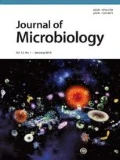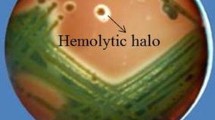Abstract
In this study, an antagonistic bacterium against Fusarium oxysporum was identified and designated as Pseudomonas syringae strain BAF.1 on the basis of 16S rDNA sequence analysis and physiological-biochemical characteristics. It produced catechol-species siderophore at a molecular weight of 488.59 Da and a maximum amount of 55.27 μg/ml with glucose as a carbon source and asparagine as a nitrogen source at a C/N ratio of 10:1, 30°C and pH 7. The siderophore exhibited prominent antagonistic activity against Fusarium oxysporum with a maximum inhibition rate of 95.24% and had also suppressive effects on other kinds of 11 phytopathogenic fungi in the absence of FeCl3·6H2O. Spore germination was completely inhibited by 50 μl of the siderophorecontaining solution, and the ultrastructures of mycelia and spores were also considerably suppressed by siderophore treatment as established by electron microscopy observation. These results indicate that the siderophore produced by Pseudomonas syringae BAF.1 could be potentially used for biocontrol of pathogenic Fusarium oxysporum.
Similar content being viewed by others
References
Arnow, L.E. 1937. Colorimetric determination of the components of 3, 4-dihydroxyphenylalanine tyrosine mixtures. J. Biol. Chem. 118, 531–537.
Bradley, G.G. and Punja, Z.K. 2010. Composts containing fluorescent pseudomonads suppress fusarium root and stem rot development on greenhouse cucumber. Can. J. Microbiol. 56, 896–905.
Bull, C.T., Wadsworth, M.L., Sorensen, K.N., Takemoto, J.Y., Austin, R.K., and Smilanick, J.L. 1998. Syringomycin E produced by biological control agents controls green mold on lemons. Biol. Control 12, 89–95.
Bultreys, A. and Gheysen, D. 2000. Production and comparison of peptide siderophores from strains of distantly related pathovars of Pseudomonas syringae and Pseudomonas viridiflava LMG2352. Appl. Environ. Microbiol. 66, 325–331.
Chaiharn, M., Chunhaleuchanon, S., and Lumyong, S. 2009. Screening siderophore producing bacteria as potential biological control agent for fungal rice pathogens in Thailand. World J. Microbiol. Biotechnol. 25, 1919–1928.
Cordova-Alboresa, L.C., Zapotit, E.S., Ríosc, M.Y., Barrera-Nechaa, L.L., Hernández-Lópeza, M., and Bautista-Banosa, S. 2016. Microscopic study of the morphology and metabolic activity of Fusarium oxysporum f. sp. gladioli treated with Jatropha curcas oil and derivatives. J. Microsc. Ultrastructure 4, 28–35.
Diaz, M.E., Villa, P., and Frías, A. 2002. Evaluation of the siderophores production by Pseudomonas aeruginosa PSS. Rev. Latinoam. Microbiol. Parasitol. 44, 112–117.
Emmert, E.A. and Handelsman, J. 1999. Biocontrol of plant disease: a (Gram-) positive perspective. FEMS Microbiol. Lett. 171, 1–9.
Errampalli, D. and Brubacher, N.R. 2006. Biological and integrated control of postharvest blue mold (Penicillium expansum) of apples by Pseudomonas syringae and cyprodinil. Biol. Control 36, 49–56.
Gajbhiye, A., Rai, A.R., Meshram, S.U., and Dongre, A.B. 2010. Isolation, evaluation and characterization of Bacillus subtilis from cotton rhizospheric soil with biocontrol activity against Fusarium oxysporum. World J. Microbiol. Biotechnol. 26, 1187–1194.
Gupta, C.P., Dubey, R.C., and Maheshwari, D.K. 2001. Antibiosismediated necrotrophic effect of Pseudomonas GRC1 against two fungal plant pathogens. Curr. Sci. 81, 90–94.
Gupta, C.P., Dubey, R.C., and Maheshwari, D.K. 2002. Plant growth enhancement and suppression of Macrophomina phaseolina causing charcoal rot of peanut by fluorescent Pseudomonas. Biol. Fertil. Soils 35, 399–405.
Kirner, S., Hammer, P.E., Hill, D.S., Altmann, A., and Fischer, I. 1998. Functions encoded by pyrrolnitrin biosynthetic genes from Pseudomonas fluorescens. J. Bacteriol. 180, 1939–1943.
Leeman, M., Den Ouden, F.M., Van Pelt, J.A., Dirkx, F.P.M., Steijl, H., and Bakker, P.A.H.M. 1996. Iron availability affects induction of systemic resistance to Fusarium wilt of radish by Pseudomonas fluorescens. Phytopathology 86, 149–155.
Mathiyazhagan, S., Kavitha, K., Nakkeerans, S., Chandrasekar, M.K., Renukadevi, P., and Krishnamoorthy, A.S. 2004. PGPR mediated management of stem blight of Phyllanthus amarus (Schum and Thonn) caused by Corynespora cassiicola (Berk and Curt) wei. Arch. Phytopathol. Plant Prot. 37, 183–199.
Palleroni, N.J. 1984. Family I. Pseudomonadaceae, pp. 143–213. In Krieg, N.R. and Holt, J.G. (eds.) Bergey’s manual of systematic bacteriology, Williams and Wilkins, Baltimore, USA.
Park, Y.H., Chung, J.Y., Ahn, D.J., Kwon, T.R., Leed, S.K., and Baee, I. 2015. Screening and characterization of endophytic fungi of Panax ginseng Meyer for biocontrol activity against ginseng pathogens. Biol. Control 91, 71–81.
Santos, S., Neto, I.F., Machado, M.D., Soares, H.M., and Soares, E.V. 2014. Siderophore production by Bacillus megaterium: Effect of growth phase and cultural conditions. Appl. Biochem. Biotechnol. 172, 549–560.
Sayyed, R.Z., Badgujar, M.D., Sonawane, H.M., Mhaske, M.M., and Chincholkar, S.B. 2005. Production of microbial iron chelators (siderophores) by fluorescent Pseudomonads. Indian J. Biotechnol. 4, 484–490.
Sayyed, R.Z. and Chincholkar, S.B. 2009. Siderophore producing Alcaligenes feacalis: more biocontrol potential vis-a-vis chemical fungicide. Curr. Microbiol. 58, 47–51.
Schwyn, B. and Neilands, J.B. 1987. Universal chemical assay for the detection and determination of siderophores. Anal. Biochem. 160, 47–56.
Shenker, M., Oliver, I., Helmann, M., Hadar, Y., and Chen, Y. 1992. Utilization by tomatoes of iron mediated by a siderophore produced by Rhizopus arrhizus. J. Plant Nutr. 15, 2173–2182.
Skidmore, A.M. and Dickinson, C.H. 1976. Colony interaction and hyphal interference between Sartoria nodorum and phylloplane fungi. Trans. Brit. Mycol. Soc. 3, 57–64.
Snow, G.A. 1954. Mycobactin, a growth factor for Mycobacterium johnei: II. Degradation and identification of fragments. J. Chem. Soc. 11, 2588–2596.
Storey, E.P., Boghozian, R., Little, J.L., Lowman, D.W., and Chakraborty, R. 2006. Characterization of ‘Schizokinen’; a dihydroxamate-type siderophore produced by Rhizobium leguminosarum IARI 917. Biometals 19, 637–649.
Turgay, O.C., Gormez, A., and Bilen, S. 2012. Isolation and characterization of metal resistant-tolerant rhizosphere bacteria from the serpentine soils in Turkey. Environ. Monit. Assess. 184, 515–526.
Wang, W., Chi, Z., Liu, G., Buzdar, M.A., Chi, Z., and Gu, Q. 2009. Chemical and biological characterization of siderophore produced by the marine-derived Aureobasidium pullulans HN6.2 and its antibacterial activity. Biometals 22, 965–972.
Weller, D.M. 2007. Pseudomonas biocontrol agents of soilborne pathogens: looking back over 30 years. Phytopathology 97, 250–256.
Wensing, A., Braun, S.D., Buttner, P., Expert, D., Völksch, B., and Ullrich, M.S. 2010. Impact of siderophore production by Pseudomonas syringae pv. syringae 22d/93 on epiphytic fitness and biocontrol activity against Pseudomonas syringae pv. glycinea 1a/96. Appl. Environ. Microbiol. 76, 2704–2711.
Williamson, S.M., Guzmán, M., Marin, D.H., Anas, O., Jin, X., and Sutton, T.B. 2008. Evaluation of Pseudomonas syringae strain ESC-11 for biocontrol of crown rot and anthracnose of banana. Biol. Control 46, 279–286.
Zhou, T., Northover J., Schneider, K.E., and Lu, X.W. 2002. Interactions between Pseudomonas syringae MA4 and cyprodinil in the control of blue mold and gray mold of apples. Can. J. Plant Sci. 24, 154–161.
Author information
Authors and Affiliations
Corresponding author
Rights and permissions
About this article
Cite this article
Yu, S., Teng, C., Liang, J. et al. Characterization of siderophore produced by Pseudomonas syringae BAF.1 and its inhibitory effects on spore germination and mycelium morphology of Fusarium oxysporum. J Microbiol. 55, 877–884 (2017). https://doi.org/10.1007/s12275-017-7191-z
Received:
Revised:
Accepted:
Published:
Issue Date:
DOI: https://doi.org/10.1007/s12275-017-7191-z




